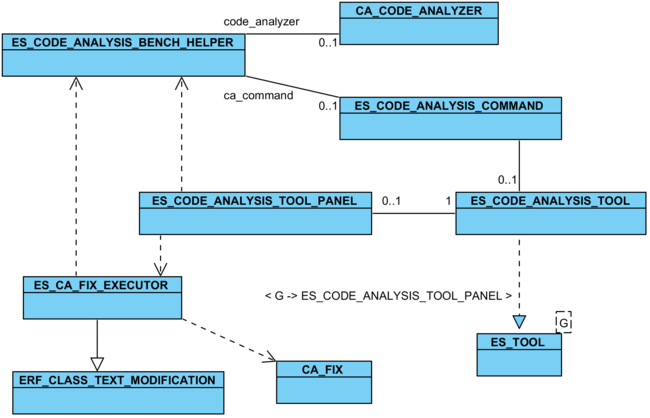Difference between revisions of "CA UI Implementation"
(initial version - moved from former chapter 7) |
(→Graphical User Interface: + class diagram) |
||
| Line 13: | Line 13: | ||
; <e>{ES_CA_SHOW_PREFERENCES_COMMAND}</e> : The command is used by the ''Preferences'' button in the panel. | ; <e>{ES_CA_SHOW_PREFERENCES_COMMAND}</e> : The command is used by the ''Preferences'' button in the panel. | ||
; <e>{ES_CA_FIX_EXECUTOR}</e> : This class [[User:Stefan/Code Analysis/Using Analysis Results#Fixing Rule Violations|fixes]] a rule violation that has been found by the code analysis tool. | ; <e>{ES_CA_FIX_EXECUTOR}</e> : This class [[User:Stefan/Code Analysis/Using Analysis Results#Fixing Rule Violations|fixes]] a rule violation that has been found by the code analysis tool. | ||
| + | |||
| + | These are roughly the class relations for the code analysis GUI: | ||
| + | [[File:CA GUI Diagram.png|thumb|center|650px|The most interesting class relations of the code analysis GUI.]] | ||
=== Caching === | === Caching === | ||
Revision as of 08:06, 7 March 2014
Graphical User Interface
The classes of the graphical user interface of the code analyzer are all located in the interface cluster of EVE, in the subfolder graphical > tools > code_analysis. Here is a short overview of what the single classes do:
-
{ES_CODE_ANALYSIS_TOOL} - Represents the code analysis GUI tool. Contains the tool title and icon, otherwise not much interesting stuff.
-
{ES_CODE_ANALYSIS_TOOL_PANEL} - The graphical panel for the code analysis tool. It contains buttons, labels, the rule violations table view, and other user interface elements.
-
{ES_CODE_ANALYSIS_COMMAND} - The command to launch the code analyzer. It can be added to toolbars and menus. It can be executed using stones. This class also handles the caching.
-
{ES_CODE_ANALYSIS_BENCH_HELPER} - A helper class for the integration of the code analysis tool. It contains shared instances of
{CA_CODE_ANALYZER}and{ES_CODE_ANALYSIS_COMMAND}, which are used by the GUI. -
{ES_CA_SHOW_PREFERENCES_COMMAND} - The command is used by the Preferences button in the panel.
-
{ES_CA_FIX_EXECUTOR} - This class fixes a rule violation that has been found by the code analysis tool.
These are roughly the class relations for the code analysis GUI:
Caching
Command-line Interface
The whole command-line functionality of the code analyzer is located in the class {EWB_CODE_ANALYSIS}. It is located in the tty cluster of EVE. {EWB_CODE_ANALYSIS} is invoked by {ES}, the root class for the batch (command-line) version of EiffelStudio. In {ES}, the invocation looks as follows:
elseif option.is_equal ("-code-analysis") then l_at_args := arguments_in_range (current_option + 1, argument_count) current_option := argument_count + 1 create {EWB_CODE_ANALYSIS} command.make_with_arguments (l_at_args)
Any command-line arguments after -code-analysis are passed on to {EWB_CODE_ANALYSIS}. This class, in its creation procedure, processes the arguments as described in Command Line Usage. Classes that were passed as command-line arguments are added to the analyzer. Then the actual execution happens in the procedure execute. EWB_CODE_ANALYSIS of course uses the code_analysis library and the previously described interface of CA_CODE_ANALYZER. After analysis a list of rule violations is output to the command-line. In the code it looks like this:
across l_code_analyzer.rule_violations as l_vlist loop if not l_vlist.item.is_empty then l_has_violations := True -- Always sort the rule violations by the class they are referring to. output_window.add (ca_messages.cmd_class + l_vlist.key.name + "':%N") -- See `{CA_RULE_VIOLATION}.is_less' for information on the sorting. across l_vlist.item as ic loop l_rule_name := ic.item.rule.title l_rule_id := ic.item.rule.id if attached ic.item.location as l_loc then l_line := ic.item.location.line.out l_col := ic.item.location.column.out output_window.add (" (" + l_line + ":" + l_col + "): " + l_rule_name + " (" + l_rule_id + "): ") else -- No location attached. Print without location. output_window.add (" " + l_rule_name + " (" + l_rule_id + "): ") end ic.item.format_violation_description (output_window) output_window.add ("%N") end end end if not l_has_violations then output_window.add (ca_messages.no_issues + "%N") end


